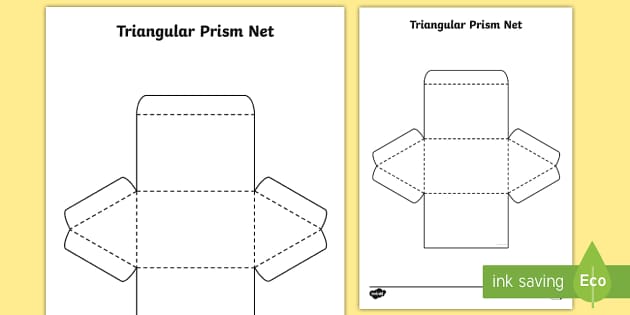

As a result, the number of faces on a prism equals the number of sides on its bases.A net is a flattened out 3-dimensional solid. The basis polygons (triangles) have three sides, giving triangular prisms three faces. We can consider that there are three rectangles connecting the edges of each base in an unfolded prism (let’s suppose we name it ABCD, CDEF, and EFGH). A triangular prism, or a prism with a triangle on either side, is the name for this unique box.Įven though we generally say that the triangular prism has five faces, faces, and bases. Assume your box’s top and bottom are now triangles instead of rectangles. The tops and bottoms of most boxes are rectangles or squares. A prism is a three-dimensional solid structure with two comparable ends joined by parallel lines of equal length, as stated in the preceding article. Other varieties of prisms include rectangular, square, and pentagonal prisms, in addition to triangular prisms. Angle of prism refers to the angle formed by refracting surfaces and refracting edges. Through rectangular bases, the edges and vertices are linked together. In a triangular prism, there are five faces, six edges, and six vertices. Triangles serve as the bases, while rectangles serve as the lateral faces. The triangle and rectangle are two-dimensional figures that make up the triangular prism. The cross-section of any given rectangular prism is rectangular.There are parallelograms on the lateral sides of an oblique rectangular prism.The lateral sides of a right rectangular prism are rectangles.Faces that are either the same or congruent in opposite directions.Like the cuboid, it has three dimensions: length, breadth, and height.A rectangular prism’s top and bottom are always rectangles.A rectangular prism has a total of six faces, twelve edges, and eight vertices.Let’s discuss some of the properties of a rectangular prism – Real-life things that are in rectangular prism shape include a book, an eraser, and a pencil box. A rectangular prism is a common form found in daily life. Let’s discuss a few instances of rectangular prisms. It contains a total of six faces, with three pairs of identical opposing faces, suggesting that in a rectangular prism, all opposing faces are similar.Īny rectangular prism you’ll ever come across will have three dimensions: length, width, and height.Ī rectangular prism’s lateral faces are parallelograms. What is Rectangular Prism?Ī rectangular prism is one having rectangular bases (the top and bottom faces). A uniform triangular prism is a right triangular prism with equilateral bases and square sides that is relatively common.

A triangular prism, thus, has five faces, nine edges, and six vertices.Ī polyhedron with a triangular base is sometimes known as a triangular polyhedron. The two triangular faces are congruent with each other, as are the three lateral faces, which are in the shape of rectangles.

Definition of Triangular PrismĪ three-dimensional polyhedron with three rectangular faces and two triangular faces is known as a triangular prism. If you want to know more about the area as well as the volume of various types of prisms you can visit the Cuemath website. In this article, we will learn more about the triangular prism.

Two triangular bases and three rectangular sides make up a triangular prism. The name of a prism is determined by its two bases, which might be triangles, rectangles, or any polygon.Ī prism with triangle bases, for example, is known as a triangular prism, whereas a prism with a square base is known as a square prism, and so on. Are you familiar with the terms prism? A prism is defined as a solid object with flat sides, as well as two identical bases, and an equal cross-section all the way around.


 0 kommentar(er)
0 kommentar(er)
